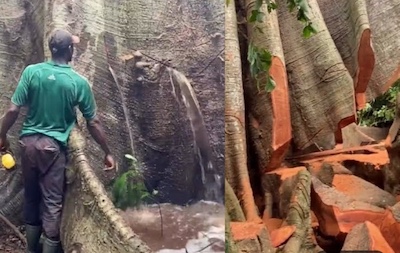Water Gushing from 150-Year-Old Onyina Tree in Ghana: Science or Spiritual Power ? Some eyewitnesses explain how it happened?
In a remote village in Ghana, a 150-year-old Onyina tree, scientifically known as Ceiba pentandra, has become the center of a viral phenomenon that has captivated locals and sparked widespread debate. As loggers attempted to cut down the towering tree, revered for its cultural and spiritual significance, water began gushing from its trunk in a dramatic display.
Water Gushing from 150-Year-Old Onyina Tree in Ghana: Science or Spiritual Power? [WATCH]
Eyewitnesses, speaking in the Ghanaian language Twi, described the event as extraordinary, with one claiming, “This is not just a tree; it cannot be easily brought down.” The spectacle has drawn crowds, with many attributing the phenomenon to the tree’s spiritual essence, while others seek a scientific explanation.
The Onyina tree, deeply rooted in Ghanaian tradition, is believed by locals to house the spirits of ancestors, making it a sacred symbol in the community. According to an eyewitness, the tree was sold to loggers by a 92-year-old man whose father once tended the land around it, suggesting the tree’s age exceeds 150 years. When the chainsaw pierced its trunk, water poured out like a flood, astonishing onlookers. “This is medicine pouring away,” one villager remarked, lamenting the lack of containers to collect the water. The logger, described as spiritually strong, persists in his efforts, climbing the tree to continue his work despite its resistance.
For many in the village, the gushing water is a sign of the tree’s spiritual power fighting back against its destruction. In Ghanaian culture, certain trees are seen as more than physical entities, embodying ancestral spirits and serving as guardians of tradition. The community’s belief in the tree’s sacred nature has fueled speculation that the water is a divine protest against deforestation. “You cannot fell this tree,” an elder declared, emphasizing its resilience and cultural weight. This perspective has resonated widely, contributing to the story’s viral spread across social media platforms like YouTube.
Scientifically, the phenomenon has a more grounded explanation. The Onyina tree, common in humid tropical environments, can store thousands of liters of water in its trunk due to capillary action and root pressure. When cut, this stored water is released under pressure, creating the dramatic gushing effect observed. Botanists note that such trees are adapted to survive in regions with fluctuating water availability, making them vital to local ecosystems. However, this scientific rationale does little to sway the villagers, who see the event as a clash between nature’s power and human intervention.
The incident highlights a broader tension between cultural beliefs and modern development in Ghana. Deforestation, a growing issue in the region, threatens not only ecological balance but also cultural heritage. Studies estimate that deforestation has contributed to over half a million heat-related deaths in the tropics over the past two decades, underscoring the environmental stakes. The Onyina tree’s story serves as a microcosm of this crisis, raising questions about how to balance progress with the preservation of natural and cultural landmarks. For the villagers, the tree’s resistance is a call to protect their heritage.
As the video of the gushing tree circulates online, it has sparked discussions about the intersection of science and spirituality. Viewers are divided: some marvel at the tree’s biological adaptations, while others interpret the event as a spiritual warning. The Ghana Trends Media channel, which shared the footage, translates the Twi-language eyewitness accounts into English, making the story accessible to a global audience. The video invites viewers to weigh in on whether the phenomenon is a natural marvel or a spiritual sign, amplifying its reach and engagement.
Ultimately, the Onyina tree’s story is more than a viral moment; it’s a reminder of the complex relationship between humanity, nature, and tradition. As Ghana grapples with deforestation and environmental challenges, the gushing tree stands as a symbol of resilience and a call for sustainable practices. Whether viewed through a scientific or spiritual lens, the event urges us to reconsider how we interact with our environment. As one villager put it, “This tree is very old, and you think it’s easy to cut? It’s not easy.” The debate continues, with the tree’s legacy enduring in both hearts and headlines.



